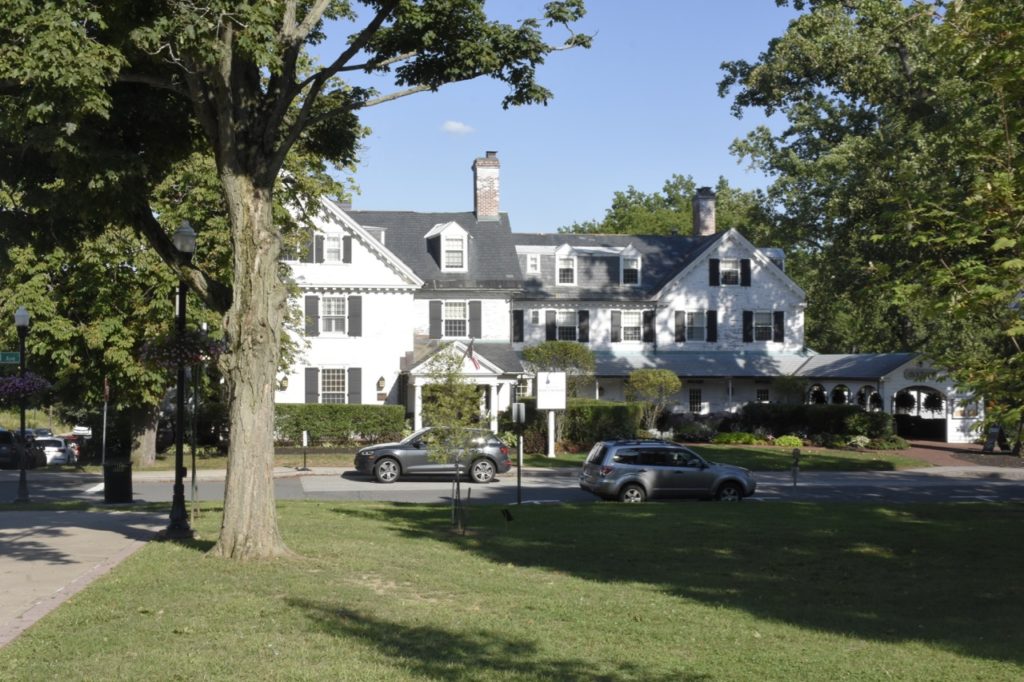Landscape, Streetscape and Skyscape: The Aesthetics of Planning in Amherst

The Inn at Boltwood (formerly the Lord Jeff) on the Amherst Common. Photo: Art Keene.
by Michael Greenebaum

I invite readers to reflect on your walks on Amherst’s streets, your experiences in Amherst’s public green spaces, your views of Amherst’s buildings and of Amherst’s skylines, lawns, cornices, gables, steeples, fences, hedges and, of course, trees. When you drive in Amherst, what streets give you pleasure or even give you a thrill? I further invite you to consider the way in which our town’s buildings, public and private, reflect its history and tell a story about us. My general term for considerations such as these is “aesthetics.” I borrow this notion from art theory, since in its essence the aesthetics of planning is the creation of public art. I want to associate aesthetics with the idea of “good fit”, which I take from architect Christopher Alexander. The tools of aesthetic analysis in art are exactly relevant to town planning. Just as aesthetic analysis can deepen our appreciation, enjoyment and awe when viewing art, hearing a symphony, or reading a poem, so too should it play a vital role in town planning.
One central question that the aesthetics of planning ought to help us address is how a proposed construction or space achieves a capacity to comfort, delight, amaze and/or disturb us. What views sustain these capacities over repeated viewings? Entering Amherst from the west on Route 9, one leaves several miles of commercial strips and suddenly encounters green lawns, shrubs and trees. That moment continues to sustain me over many years of almost daily driving. Years ago someone wanted to build a drugstore on that green expanse. Thankfully the town said no and reaffirmed its appreciation for that space as an introduction to Amherst. But will the town always do so?
The Business Improvement District (BID) wants to build a permanent bandstand on the Common. Right now the Common serves two opposite but essential functions: as a place for the community to gather and as a place to be quiet and alone in the midst of downtown noise and bustle. The Common is surrounded by buildings which are emblematic of Amherst’s history and character: the excellent commercial blocks as well as the splendid Grace Church, the elegant Amherst College dorms, and the absurd but wonderful Town Hall. All are worthy of time spent steadily looking at them in appreciation at how they frame our public space.
I recently wrote about a truly vexing question: Who decides what our public spaces should look and feel like? Who decides whether a bandstand enhances or diminishes our experience of the common? This question has an urgency, since the most recent big buildings downtown are a stain on our town center. We have a multiplicity of boards and committees charged with overseeing our zoning bylaw and monitoring the frequent exemptions from its strictures that are requested by builders and designers. And yet in spite of (or possibly because of) this multiplicity, these new buildings in Amherst Center detract from the feel of, enjoyment of, and appreciation of downtown.
There has been much good planning and building in Amherst. The redesigned Groff Park will be a joy for generations. In North Amherst, the Mill District gives me great pleasure and I look forward to the continued redesign of the awkward intersection there so that the North Amherst Library (perhaps Amherst’s most beautiful public building) can truly be joined to the community it serves.
But I worry about downtown. I think it is time for aesthetic ideas to become part of the planning lexicon in Amherst and the review process of the Planning Board and Town Council.
Here are some questions (there are certainly others) that should be a part of any review before a permit is issued for new construction:
- How does the proposed construction improve, affect or detract from the streetscape of its neighborhood?
- How does the proposed construction affect the interplay of light and shadow?
- How does the proposed construction improve, affect or detract from the views, both distant and near, enjoyed by the public in its vicinity?
- What does the proposed construction say to us about ourselves as residents of Amherst?
- What stories will the proposed construction tell in the next century about the values and the priorities of the first decades of this century?
I find it difficult to end this commentary because there is so much more to be said. I will stop in the hopes that readers will say that “much more,” or argue against the aesthetic position I have taken, or challenge me to take more seriously the financial arguments which seem to be the sole supports of our large downtown buildings. The time for this conversation is now.

Thank you for the series of articles. Unfortunately the Planning Board does not seem to include the breadth of viewpoints you mention. This diminished diversity of ideas will most likely lead to inferior outcomes. We are building structures that are widely considered inappropriate, that will be present for many generations. I often wonder if even the business, development, finance and real estate community know what is in their better interest, never mind the town as a whole. We often create a false dichotomy between public and private interests. Our planning and development ought to be reflective of the collective wisdom of our entire community, and not misguided by narrow interests such as “we need this development to fund the capital projects we want”. Another type of “false dichotomy”, I think. Bob Greeney
Hear, near, Michael! Just as the rice serves as the “ground” for the “figure” of the meal, so should the Town Common serve as the ground for the figure Amherst Center’s architecture: let’s keep that ground clear and green. Rob Kusner